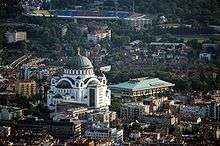
Sava river in Belgrade, view from Kalemegdan fortress.
Belgrade is the capital and largest city of Serbia. It is located at the confluence of the Sava and Danube rivers, where the Pannonian Plain meets the Balkans. Its name translates to White city. The city has a population of 1.23 million, while over 1.65 million people live in its metro area (which encompass administrative limits of City of Belgrade). Belgrade was the capital of Yugoslavia (in various forms of governments) from its creation in 1918, to its final dissolution in 2006.
Quotes
- I am Bosnian by nationality... [T]he fact that my mother gave birth to me at a hospital in Belgrade does not mean anything.
- Jovan Divjak, as quoted in "JOVAN DIVJAK: JA SAM BOSANAC" (11 September 2007), Sense Tribunal, Sense Agency
- Serbia is the ideal destination for anyone looking for an adventurous holiday, without any long-haul flights, and a love of meeting the locals. You get a real feeling of being in an exotic location, where the tectonic plates of Islam, Orthodox Christianity and Roman Catholicism, alongside socialism and capitalism, have all collided in the past.
- Guardian: The Observer Travel
- Night falls in the capital of the former Yugoslavia, and music fills the air. Everywhere.
- New York Times[citation needed]
- This slightly disheveled air, combined with the city's vibrancy, fine restaurants, street cafes and northern European atmosphere, would make it an ideal place to spend a few days...
- Lonely Planet[citation needed]
- Once located at the border between the Turkish and Austro-Hungarian empires, it combines Central European with more Oriental influences, and adds a style and spirit of its own. I can only put it one way: Belgrade is cool.
- Bootsnall: Serbia Travel Guide
- Mist, not smoke, rose from the water at the confluence of the Danube and the Sava rivers. This is the point where the biggest city in the Balkans began. Belgrade's origins lie in a Celtic settlement on a bluff with superb views across the plains. Today, the horizon is scarred with chimneys and tower blocks, but the drama of the location remains.Beneath the ridge, skeletal trees accompany the Sava to the point where it merges into, and amplifies, the artery of eastern Europe. As the Danube continues its stately progress towards the Black Sea, you can understand why the Romans, Slavs, Turks and Austrians took turns to command these heights. Nowadays, the gently decaying stratum of history known as Belgrade fortress, draped upon the high ground, is the preserve of tourists.
- Independent.co.uk: "Back to the Balkans"
- City break- Belgrade: If you've seen Budapest and Kraków, consider heading somewhere new in Eastern Europe. Belgrade is a fast-paced modern European capital, successfully banishing the shadows of war. The city's history has deprived it of the richness of historical buildings of other capitals, but it still boasts plenty of impressive leftovers from the Austro-Hungarian empire and a fascinating citadel with architectural influences from its many occupiers. A visit here is all about enjoying the modern architecture, dynamic atmosphere and excellent nightlife. Belgrade is best seen from the water - the city has a beautiful setting at the confluence of the Sava and Danube rivers. If that's not enough to tempt you, the tourist office literature explains that Belgrade is a city of about two million people. More than half of them are women, renowned for their beauty, cleverness and unpredictability.
- "The 2004 hot spots", Guardian Unlimited/The Observer
External links

This article is issued from
Wikiquote.
The text is licensed under Creative
Commons - Attribution - Sharealike.
Additional terms may apply for the media files.
